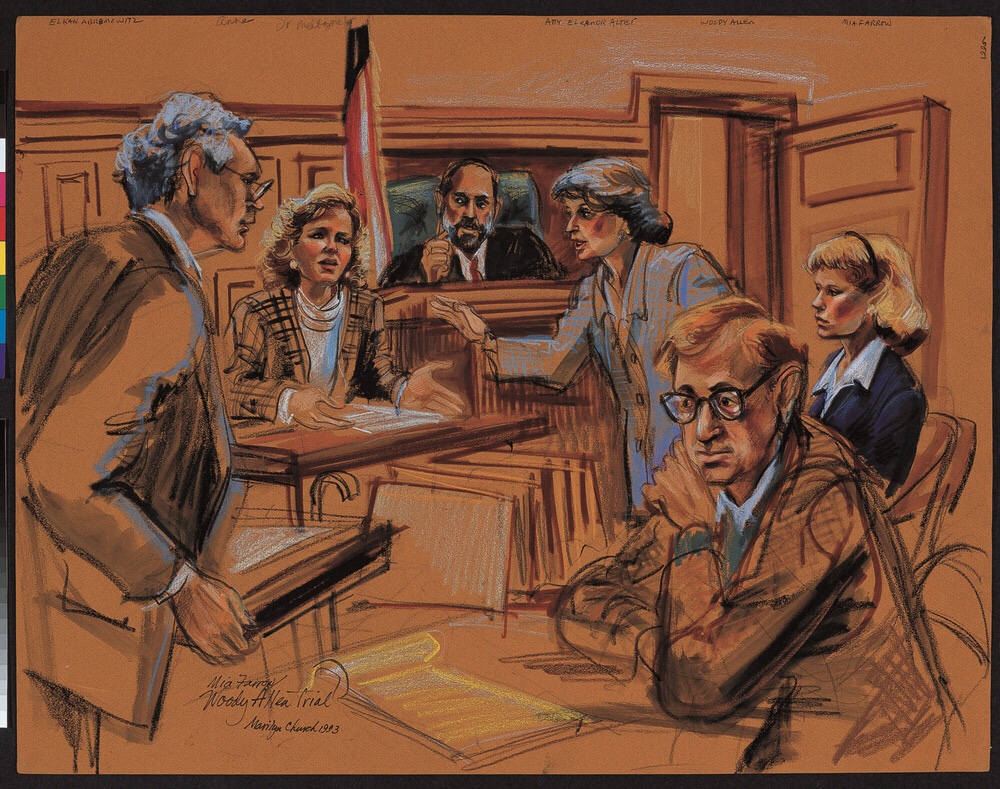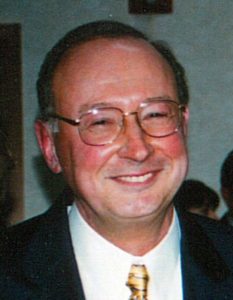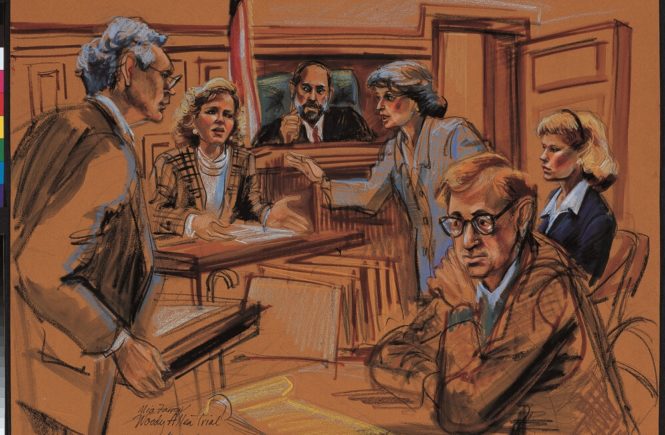
The Vanity Fair article/listicle about Mia Farrow’s allegations against Woody Allen, and the subsequent events, are presented as ‘facts’. Many of them are actually opinion, the opinions of author Maureen Orth, and the facts are vague and selective. The article also presents extremely selective facts, often leaving out vital details.
What follows is 10 responses to Orth’s 10 ‘facts’ or points. We also provide sources. You know, sources?
1. Mia never went to the police about the allegation of sexual abuse.
Yes. She went to Dr Susan Coates, who doubted Mia because Mia was, in an opinion, too calm for someone reporting abuse of their child. It is disingenuous to think that this call, to a doctor, would not be referred to the police, or automatically set into motion a criminal matter.
This point is trying to address the accusation that Mia Farrow did not do the right thing when she heard allegedly discovered Allen abuse her child. This comes from both Doctor Coates, and house staff such as Monica Thompson (see below). But it also comes from the video that Mia Farrow made, some time after the Doctor’s appointment. Those who have seen it says it was Farrow filming in Dylan, in several locations, inside and outside, talking about the abuse. Farrow claims it was filmed the next day but not presented to police immediately. Thompson says Farrow filmed for days. The description of the various locations and the editing done suggests Farrow is lying.
Did Mia Farrow act appropriately, on August 5 and the days that followed? There seems to be significant doubt here.
2. Allen had been in therapy for alleged inappropriate behavior toward Dylan with a child psychologist before the abuse allegation was presented to the authorities or made public.
Allen is probably the most famous therapy patient on the planet. Even then, this is a stretch, unless I missed something.
A lot came out in 1993, including claims by Mia Farrow that she first became suspicious of Allen being too close to Dylan in 1987-1988. Dylan would have been around 3. Often trotted out as evidence of behaviour, that child psychologist has a name. Dr Susan Coates called Allen’s relationship with Dylan “inappropriately intense”, but she was also clear that it was not sexual.
It was an unconventional family unit (to put it lightly) who used therapists for all aspects of their lives. Mia Farrow had 11 children. Allen, by everyone’s account, didn’t care for them, he didn’t live in the same house with them, and never saw them. In Allen’s version of events, 87-88 is when their relationship essentially stopped, and having their own children was a large factor. They started trying to work on their relationship with therapists.
It is very selective to suggest that this was a a special, highlighted aspect of Allen and Farrow that stretches back before 1993.
3. Allen refused to take a polygraph administered by the Connecticut state police
True. But he did take one, just not by the Connecticut state police. Orth points out Mia Farrow did not.
Allen was also never asked by CT State Police to have one. The test was administered by an impartial professional named Paul Minor. He was the former chief of polygraphs at the FBI and the US military and was one of the most respected people in the field. Minor also answered questions about the process with investigators. There was nothing unusual about this.
This is a weird one. The only reason to bring this up is to suggest Allen had something to hide. In fact, he was extremely helpful with investigators. He was doing everything he could to win the custody battle for his kids, and spent millions of dollars and many years on the case. Maco (see Point 7) denied it as evidence.
Allen was helpful with investigators and ultimately sat, and passed a lie detector test.
4. Allen subsequently lost four exhaustive court battles—a lawsuit, a disciplinary charge against the prosecutor, and two appeals—and was made to pay more than $1 million in Mia’s legal fee
True. Allen lost custody of his children. He was however, investigated thoroughly and no evidence was found he abused Dylan Farrow. Mixing up the two seemed to be Farrow’s point, which Orth plays brilliantly.
Allen lost several court cases, but none of those cases were about the allegations of abuse.
5. In his 33-page decision, Judge Wilk found that Mr. Allen’s behavior toward Dylan was “grossly inappropriate and that measures must be taken to protect her.
Yes, he did. Why? See point 7.
But also, Orth leaves out that Wilk was not the judge presiding on the abuse case. Wilk was presiding over Allen’s custody battle between Farrow and Allen. Wilk is not presented with evidence on the abuse trial. He wasn’t involved in that. He just got a fax from Frank Maco.
Wilk was going on all testimony, such as Coates’ comments that Allen is inappropriate, but not sexually so, with Dylan.
Yes, there is all sorts of claims of bias against Wilk made by people. But that’s not a fact either. Again, nothing sexual or abusive was found by Judge Wilk, who was in no part of the investigation into that abuse.
Judge Wilk did not preside over the charges of sexual abuse. His decision on Allen and Farrow’s custody battle was not based on access to the evidence of investigators, and the scope went well beyond that allegation.
6. Dylan’s claim of abuse was consistent with the testimony of three adults who were present that day.
One is Monica Thompson. She recanted her testimony in 1993, a fact Orth clearly leaves out. But the New York Times remembers. Thompson also claims that Farrow hit her children, was happy with the results the doctors gave her that Dylan was abused, and many more damning things. She had lied because she was afraid she would lose her job.
Nanny no.2. Kristie Groteke. She managed to sell the story for a TV movie called Love And Betrayal: The Mia Farrow Story. She testified that she lost track of Dylan at one point for 15-20 minutes. Thompson claims that later, Groteke said it was less than five. It was not a planned event, and any abuse (allegedly in an unlock able attic with other people in the house, a house owned by the person you are fighting in court with) would have been extremely opportunistic. In any event, Allen was in the bathroom for those 5 or 20 minutes, and his time was accounted for, if not seen by Groteke’s eyes.
Babysitter Alison Stickland says she came home to find Allen’s head in Dylan’s lap, watching TV. An incident separate to the apparent attic event.
There was, as the Washington Post wrote, a Clash Of the Nannies in this case. That was the headline. Accusations of who paid whom, who’s parenting was better, who hit who. It is very disingenuous of Orth to claim that the adults fell in line in anyway. There is no consensus here, the adults present do not agree.
Plus, Dylan’s account was not consistent with her own story, according to Yale-New Haven (see below). Orth doesn’t follow up with her point that Dylan’s account matches Nanny No.2 and the Babysitter’s. Because even those two do not agree with each other.
Let’s be clear. Dylan’s accusation was that she was alone with Allen. No one, absolutely no one, saw this, or could corroborate. She was ALONE. All that Strickland and Groteke agree on is the events around the alleged incident.
There is many conflicting stories about what happened on that day. Some adults agree with some aspects of the day, like the whereabouts of various people. But no adults saw any actual abuse take place.
7. The Yale-New Haven Hospital Child Sex Abuse Clinic’s finding that Dylan had not been sexually molested, cited repeatedly by Allen’s attorneys, was not accepted as reliable by Judge Wilk, or by the Connecticut state prosecutor who originally commissioned them.
The Connecticut State Prosecutor, you should jump to point 9. His name is Frank Maco. And yes, he rejected the findings. Why? What other evidence did he have? He has never said.
Judge Wilk, the lawyer who ultimately did not grant any custody of Allen’s children to him. Yes, he clearly disregarded the findings. Why? He has never said, outside of him judging Allen to be an inappropriate parent. He has never commented on whether he had access to evidence that would go against the investigators, like Maco did.
What was wrong with The Yale-New Haven Hospital Child Sex Abuse Clinic’s findings? Which are available to read online for anyone who cares to.
Orth leaves the answer open – it’s classic leading down a path. A lot of people stand by the Yale-New Haven findings. Not least of all the investigators themselves, who spent 14 months investigating.
Orth makes some points that the lead doctor, Dr John Leventhal, didn’t examine Dylan. But his team did. That’s why he has one. The wealth of evidence and materials they looked into over 14 months can’t be done by one person. To attack Leventhal because he signed off on his team’s work is a bit rich.
Orth also makes a point that no psychologists or psychiatrists were on the panel. That’s because Farrow would not allow Dylan any counselling or mental health help after the event.
8. Allen changed his story about the attic where the abuse allegedly took place.
A very selective reading of the facts. Allen said he had never been in the attic, but turns out he had. Let’s add a few more facts. According to Dylan’s brother Moses Farrow:
I assure you, there was no electric train set in that attic. There was nothing practical about that space as a place for kids to play, even if we wanted to. It was an unfinished attic with exposed fiberglass insulation. It smelled of moth balls and there were mouse traps and poison pellets left all around. My mother used it for storage where she kept several trunks full of hand-me-down clothes, that sort of thing. The idea that the space could possibly accommodate a functioning electric train set, circling around the attic, makes no sense at all.
Allen, famously claustrophobic and can barely get into elevators, had a natural aversion to attics as well. Allen has made the point that he doesn’t go into places that contained, but the spin has turned into Allen telling a lie about his whereabouts.
This attic has no lock. It’s in Mia Farrow’s house. The point, made often, is how improbable it would be for the attic to be used for anything by Allen, or anyone. Allen, and his lawyers, were arguing against the attic as a space.
That Allen had been in the attic, he must have therefore abused his daughter? That is a big stretch.

9. The state attorney, Maco, said publicly he did have probable cause to press charges against Allen but declined, due to the fragility of the “child victim.”
Frank Maco. Orth probably referred to him by only his last name because any googling of his full name brings up interesting results. Maco did indeed say publicly that he had probably cause. Further, he sent those comments to the judge presiding over the Farrow/Allen custody case.
Allen sued Maco for making the comment. A panel judged Maco’s actions to be “was inappropriate, unsolicited and potentially prejudicial” and also “violated the prosecutor’s obligation to the accused.” You can read about it in the New York Times. The Times claims that lawyers are usually not reprimanded for public comments, but the panel did give a damning assessment.
Testifying in 1993, and asked specifically by a panel if he truly had the evidence to justify the comment, Maco downgraded it to “Arguably I do”. No other living soul knows anything else about this evidence, none of his staff, investigators, or the Farrows.
The case ran until 1996. Maco was suspended for much of that time, losing his living, and costing the states hundreds of thousands of dollars in defence. But let’s put it this way. In this entire sorry affair, only one person ever committed an act that was deemed worthy of criminal trial – Frank Maco.
Maco made a statement in 2014. I present it without comment, other than whatever proof Macs has or had, he has never made clear to anyone publicly, or are there any accounts of him doing so privately. The she he refers to is Farrow.
“I hope she has access to that statement, to know what I did and why I did it,” Maco said. “I hope she finds some peace and solace at this time.”
10. I am not a longtime friend of Mia Farrow’s, and I did not make any deal with her.
Very much an opinion. I would counter than Orth’s reputation is very invested in this case. She was the first to break Farrow’s allegations about Dylan, and over the years has had special access to the Farrow family. She did the investigation, and made the conclusion. The conclusion she made – that Allen is guilty – has been roundly questioned by experts involved in the case.
Her credibility, and her investigation skills, have been questioned many times – in 1992 and over the years. She even links to criticisms of her in her final point (from Fire And Fury author Michael Wolff, no less).
Orth is not a side player – she is not just any journalist or writer who could have found this story. She clearly has a special relationship with Farrow.
Orth is extremely selective and disingenuous with her ‘facts’. She knows there is doubt across the board, but she is trying to make a point. She leaves out vital information, names and context. She doesn’t want you to look further. This isn’t a list of facts – it’s a piece clearly written with an agenda.

